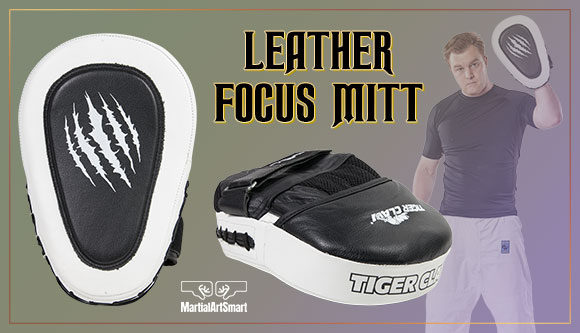For The Silk Road Kung Fu Friendship Tour Part 37, click here.

Visit to Phuket Wushu School, ancient Phuket, 3,000-year-old cave art, ancient land and maritime connections between Thailand, China, Malaysia, Indonesia, and India, two of Phuket’s many museums, “Fighting for Success” an extraordinary insider’s view into the Muay Thai industry in Thailand by Dr. Lynne Miller and a mind-stopping sunset at Nai Harn Beach.

Visit to Phuket Wushu School
November 16, 2021 - A little after 8:00 am I had already done two hours of research on ancient Thailand and just finished washing breakfast dishes when I got a phone call, an invitation to visit one of the morning classes at Shifu Li Yu Zhong’s training center called “Phuket Wushu School.” That sounded like an excellent start to the day and I happily accepted.
That’s so nice really. How many martial arts clubs have I visited in foreign countries since I was about 15 or so? Hundreds. How many times did someone offer to or give me a ride? Not many.
Arriving at the training center I was oh-so-pleased to find it was beautiful, shielded from the country road in front by a bamboo forest, and surrounded by nature. The facilities themselves were clean and modern, with an office just inside and large open air training center. It was not as huge as some Muay Thai schools that I’ve visited before but quite large and comfortable.
A few words about the business of martial arts training: Most people who practice martial arts don’t intend to become professional fighters. Muay Thai happens to be a big industry here in Thailand and there are many very large Muay Thai training centers but that big industry is not the norm worldwide. Most martial art students worldwide are children, and most adults who train in martial arts are those seeking health, fitness and self-defense skills, not careers as professional fighters, bodyguards, or other such noble but potentially hazardous professions.
One thing I noticed quickly was that Shifu Li’s school is “normal” in that it appeals more to regular people and families than the Muay Thai schools I had previously visited.

Certainly, this class was a bit lower-key and relaxed than the pros at some other clubs. Simultaneously it was hugely fun and a terrific workout just the same.

The first coach I talked with was called “Sep” though I later found out his name is Glai Roong. I was amazed he said he was 55 because there just isn’t any doubt, he could pass for half his age.
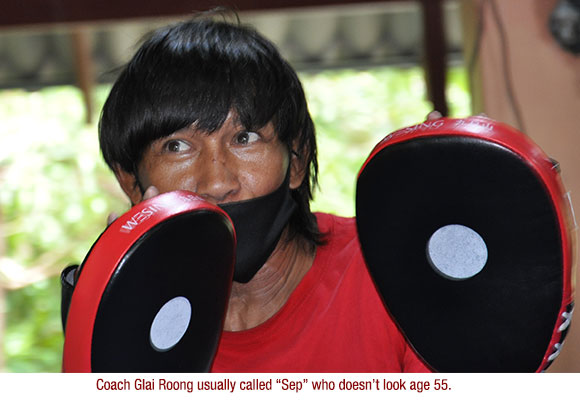
After the class I interviewed him and found out he started training at age 10, was a popular professional fighter for 10 years – fought 100 fights and won 70 of them, only eats twice a day, once at noon and with dinner at 6:00, and likes to eat “Kao Gang” which is rice with a choice of main dish usually fish or chicken, veggies, etc. He doesn’t eat a lot of fruit but loves vegetables. He is married to a Chinese lady and has a 27-year-old son. Trying to ascertain all the secrets to his youthful appearance, I asked him if he drinks. He then said: “When I was a pro fighter I drank a lot, mostly milk with Ovaltine. Now not so much.” Incidentally almost nobody here in Thailand smokes – it’s very rare. I also found out during his time as a professional fighter he trained out of Pin Sin Chai Camp in Bangkok.
I visited a small adult class with four ladies and three men attending, all of whom were interested in health and fitness. It was a class with a lot of smiles because it was fun, yes, hard work and yes involved skill development, but they hugely enjoyed their time here and worked hard during training sessions, taking – oh – a few more breaks than the pros, while totally enjoying the whole process.

The coaches obviously were very familiar with Sanda rules and methods. That said, a note about Thai training. One thing I noticed at the Muay Thai camps I visited is they work almost exclusively on combination attacks. They usually use focus pads in classes, and students learn sequences of five to seven or eight strikes that are a bit tricky, for example switching right-left, high-low and spinning with kicks/punches, elbows, and knees, obviously not in that robotic order. Their combinations blend into each other seamlessly. Defending against those kinds of combinations isn’t easy; it’s an aggressive style that focuses on attack.
It was a good sweaty hour and a half or so and I took plenty of photos and a few short videos. Even though all of the students were amateurs, they were fast enough to give me a bunch of blurry photos. All the martial art training halls I’ve visited here are covered and outdoors, which means shaded, but surrounded by bright sunshine. That means to get any good photos I must leave the camera on Auto, which is slower than high speed, but at least the camera’s computer chips can give me some well-focused and lit photos.
After the class I chatted a bit with the other Thai coach, learning his name is Gone, (though it’s pronounced more like “gun”), is from Trang, and started Muay Thai at the age of seven. During the class he mainly coached the young man in the class, a 4th generation Chinese Thai; and though they did Sanda style sparring for most of their session, he obviously had an affinity for boxing. So, it was an eclectic class mainly consisting of self-defense-oriented Sanda and Muay Thai training.
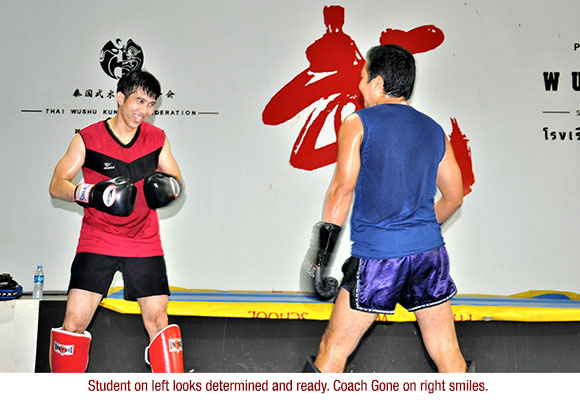
Two words for “Coach” in Thai are “Ajan” and “Kru,” though most people in all the clubs I visited refer to the coaches by their nicknames.
After class there was another scheduled, and another after that so Coach Li’s wife’s brother gave me a ride back to my hotel where I had a second breakfast as all good hobbits do.
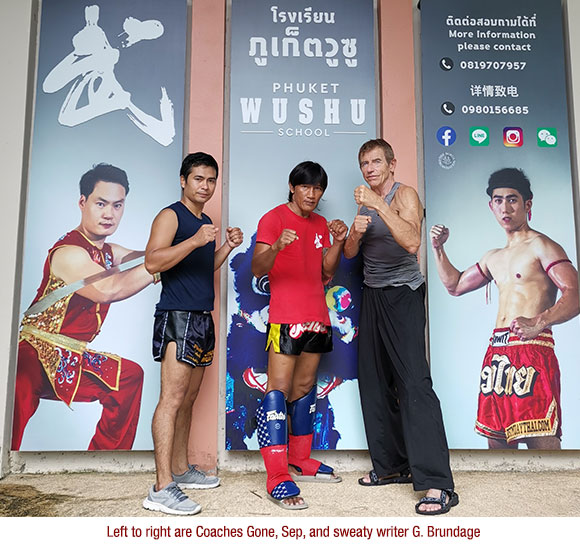
Ancient Phuket
When I was a kid, some wise traveler told me: “Always bow to the local gods.” That means show respect for local cultures and traditions. About 90% of the people in Thailand are Buddhist with its philosophy of peace and respect for life. Also here in Thailand, like almost everywhere else on earth, the warrior ethos is ancient and revered.
According to the Thai Embassy site in DC:
“Thailand encompasses some of the oldest settled areas in the world. Homo erectus, dated to between 1.6-0.5 million years ago, has been discovered here. Later prehistoric periods include the emergence of agriculture some 6,000-7,000 years ago, the Bronze Age around 4,000 years ago, and an early form of urbanization at about 2,300-2,500 years ago. Chinese records also mention the existence of towns and cities in several parts of Thailand. An early peak in population was reached between 600 and 1400 AD, with towns and large settlements surrounded by walls and moats. The kingdoms of Sukhothai and Lan Na, among other Thai principalities, were firmly established by the 13th century, when the classic and distinctively Thai style of arts, crafts and architecture was formed.”
It appears some 6,000 years ago Phuket was part of mainland Thailand.
Did you know?: Thailand and the Maritime Silk Roads
Humans have lived on Phuket Island for at least 3,000 years and possibly as long as 5,000 years as demonstrated by cave paintings found mostly in the south of Thailand.
More ancient cave paintings found in Phang Nga Bay
Most contemporary histories of Muay Thai state its history can be dated “at least to the 16th Century,” however I suspect it’s much older given Thailand’s early domestication of rice and equally early rise of city-states. Farms, villages, towns, and cities can only survive when they have the martial skills to protect their farms and trading centers.
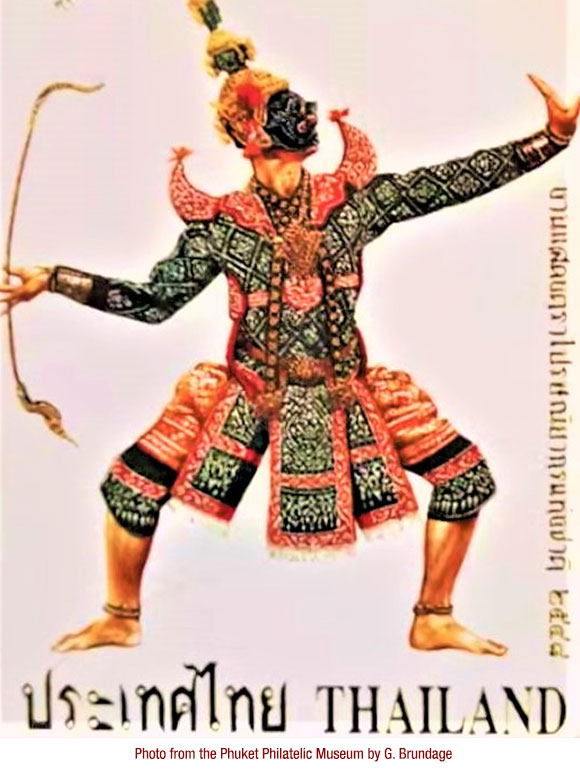
In the short article by UNESCO referenced above titled: "Did you know? Thailand and the Maritime Silk Roads," it also states:
"One of the main distinctions of Thai traders and navigators was the fact that they did not travel far from their land, as opposed to Chinese or Arab sailors for example. This was mostly due to the availability of wide resources in the region."
Did you know?: Thailand and the Maritime Silk Roads
That may be, however the reasoning is weak; never underestimate the seafaring power of an ancient coastal empire or the power of supply side economics. Also, it doesn’t take into account the Sea Gypsies.
His ancestors, former nomads who came from Indonesia nearly 300 years ago, took a spit of land in Rawai, a beach in the south of Phuket, long before the island became one of the country's most popular destinations.
COVID-19 pandemic respite for Thai 'sea gypsies' threatened by mass tourism
Most of the Sea Gypsies these days are fisher people living on the coasts of the Andaman Sea. Along the coast of Rawai Beach one can visit their village, purchase fresh sea foods of all manner and have it cooked just across the street. Families usually live off on the side streets where kids play and life goes on in a timeless manner.
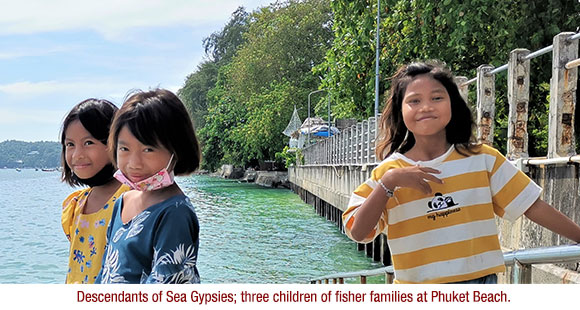

3,000-year-old cave painting
It seems highly likely there was reciprocal trade between southeast Asian countries quite early in history.
“Recent archaeological excavations in parts of Southeast Asia particularly Thailand and Indonesia have yielded objects of Indian origin such as carnelian and glass beads, inscribed carnelian and terracotta seals, ivory objects and pottery. In the paper presented at the Silk Roads Seminar in Madras argued that these were not prestige objects obtained through irregular or occasional exchanges, but that certain regions of mainland and peninsular Southeast Asia were actively involved in the organized trade networks dated between the 2nd century B.C. and the 4tn century A.D.”
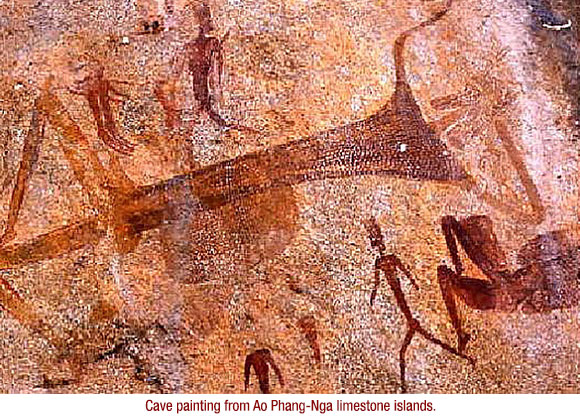
More ancient cave paintings found in Phang Nga Bay
When I first glanced at the painting, I thought for an instant that central almost horizontal figure looked very much like an Indonesian Kris (dagger).

Only upon closer inspection did I recognize it was a male figure. (If the whole truth be told, I was cooking breakfast, glanced over at my notebook computer, noticed what was surely a Kris painted on a cave wall, stopped what I was doing to look closer, then realized it was a man.) About an hour later I was in the car with Coach Li’s Thai wife and her brother on the way to their Wushu Club and mentioned this similarity. She told me there was an ancient Thai dagger that looked just like the Indonesian Kris, but mentioned it hasn’t been used in a very long time.
After class looking through my photos from the Bangkok National Museum a couple of years ago, I found this:

You can barely see the top of the blade above the wooden sheath, but it is visible and it also has that unique gradual widening at the top – which is very different from Chinese and European dagger blades. That design appears unique to South Asia. It is also interesting that the pommel (the enlarged fitting at the top of the handle) appears to look like a bird’s head. That it suggestive of the symbolic and possibly spiritual nature of the weapon. Indonesians and Malays believe each real Kris has a spirit and abound with colorful and sometimes scary legends surrounding Kris and those spirits.
This is something I hope to research further here in Thailand.
Phuket’s Post Office Museum
Phuket has no less than 10 great museums and my first visit to a museum happened rather unexpectedly. I was looking for the traditional marketplace and was escorted by a friend I call Sheikh Mubarak a gentleman about my age and a fourth generation Thai.
I met him at his house and he suggested we stop at the Post Office Museum on the way to the market. I’ve visited hundreds of museums in my life, but never before a Post Office Museum. Believe it or not it was well worth the visit small as it was, for it is a splendid time-portal through Phuket’s history at least from 1883 until today. The pictures on stamps are used to commemorate the greatness and unique features of a nation, as well as serve as unique collections of patriotism and art.
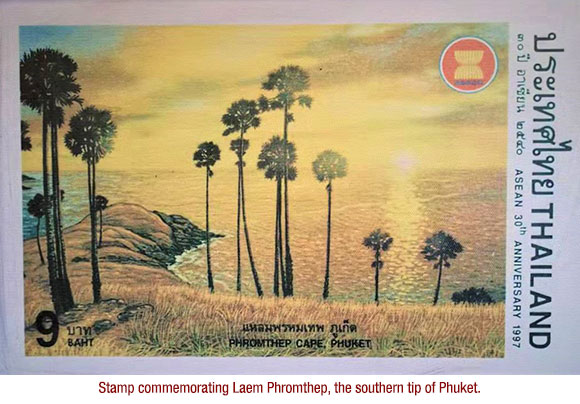
As mentioned above there are quite a number of museums on Phuket. One must-see museum is the Thalang National Museum.
Thalang National Museum

December 2, 2021 I finally got to this museum established by the Fine Arts Department in 1985. Though not large compared to most national museums, it does have some fine displays. By far the most impressive artifact was this:
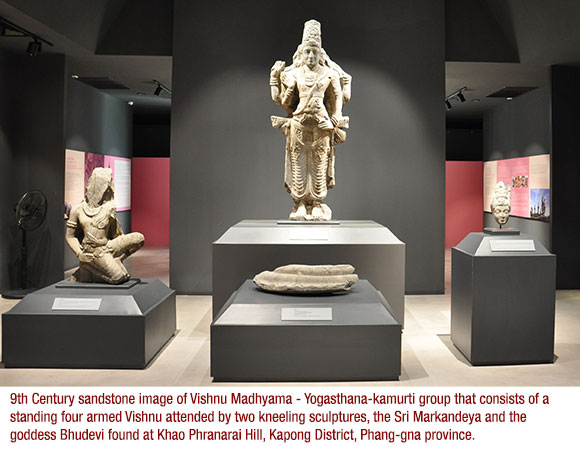
Vishnu is known as ‘The Preserver’ within the Trimurti, the triple deity of supreme divinity that includes Brahma and Shiva.

The museum also had a large collection of small Buddha tablets mostly from the 8th – 10th centuries, in addition to ancient necklaces, pottery, etc.
Fighting for Success
Throughout this Silk Road Kung Fu Friendship Tour, I tried to learn and share as much as I could about the indigenous martial arts of the lands and cultures I visit. Naturally I visited several Muay Thai schools in Phuket, interviewed the owners, when possible, got to know some of the coaches and people training there, bashed around their heavy, heavy bags for a while at least and so on.
One Muay Thai school called Sumalee Boxing Gym I found by accident after visiting Thalang National Museum turned out to have a truly extraordinary story summarized in a fascinating book titled “Fighting for Success” by Dr. Lynne Miller. It describes her 12-year journey through the ancient and modern, sometimes murky and at others noble Muay Thai industry and how she carved out a unique niche in that industry combining traditional Muay Thai training along with Yoga and high-quality sports nutrition. If the reader is a professional Sanda fighter, taolu aficionado, or is looking for practical self-defense with some great people, by all means get training from Coach Li. If the reader is an all-around martial artist as I try to be, stopping a while at Sumalee will be interesting and rewarding as well. Her book can be purchased on Amazon, Goodreads and other popular online bookstores.
It’s difficult to close this segment of the Silk Road Kung Fu Friendship Tour as the loveliness of Phuket Island shines more brilliantly the longer one stays. Sometimes a photo expresses it best.
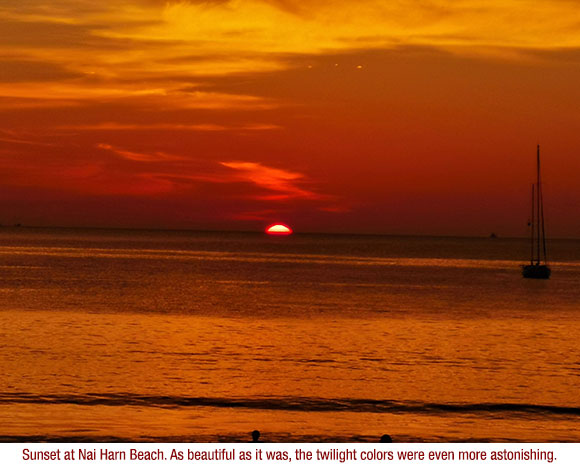
Phuket Wushu School
https://www.facebook.com/phuketwushuschool
Wushu Sports Association of Thailand
https://www.facebook.com/wushuthailandOfficial
Brief history of Phuket Island
https://www.phuket.net/visit-phuket/about/info/history
Research on ancient Thailand and the maritime Silk Roads
https://www.silkroadvirtualuniversity.org/se-asia-silk-roads.html
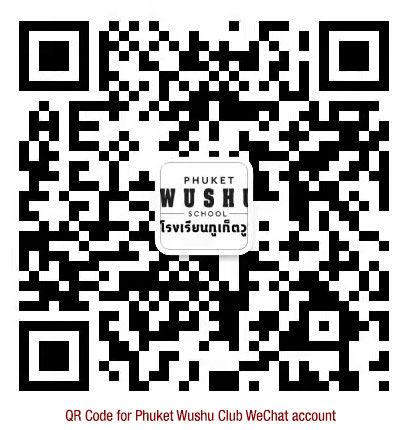
For Silk Road Kung Fu Friendship Tour Part 39, click here.
Gregory Brundage is the son and grandson of university professors and began international travel for extended periods in 1963 – 1964 traveling the Roman Roads from the UK to Rome and from Spain to Rome 1966-1967. He started Kung Fu training in 1972 and competed in 300 martial art tournaments before 1988. He was a newspaper reporter in the US 1988 – 1992 and since then has published articles in innumerable newspapers and magazines mainly in East Asia. His Kung Fu Tai Chi Magazine series include Rebuilding the North Shaolin Temple and Silk Road Kung Fu Friendship Tour. He’s retired now and contributions to keep The Silk Road Kung Fu Friendship Tour on the road can be made to: paypal.me/silkroadtraveler
![]() Print Friendly Version of This Article
Print Friendly Version of This Article












